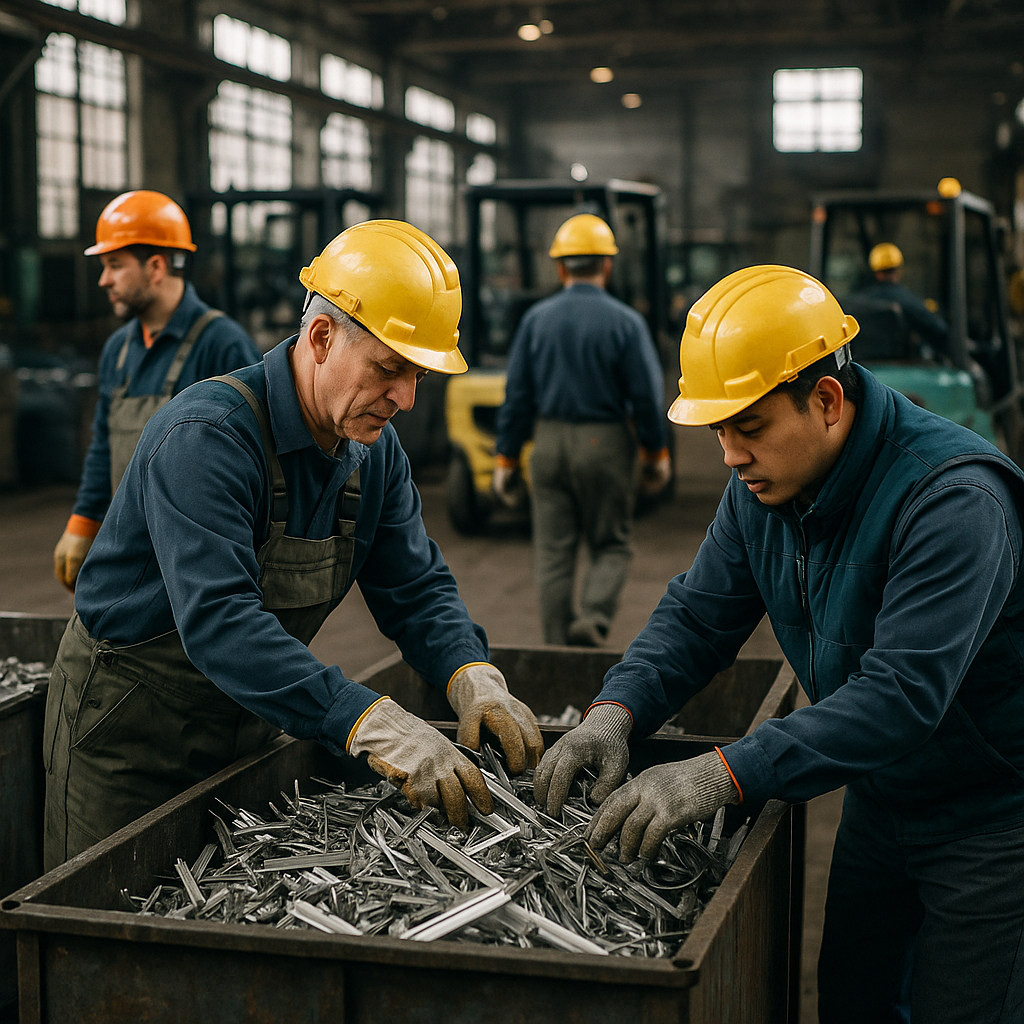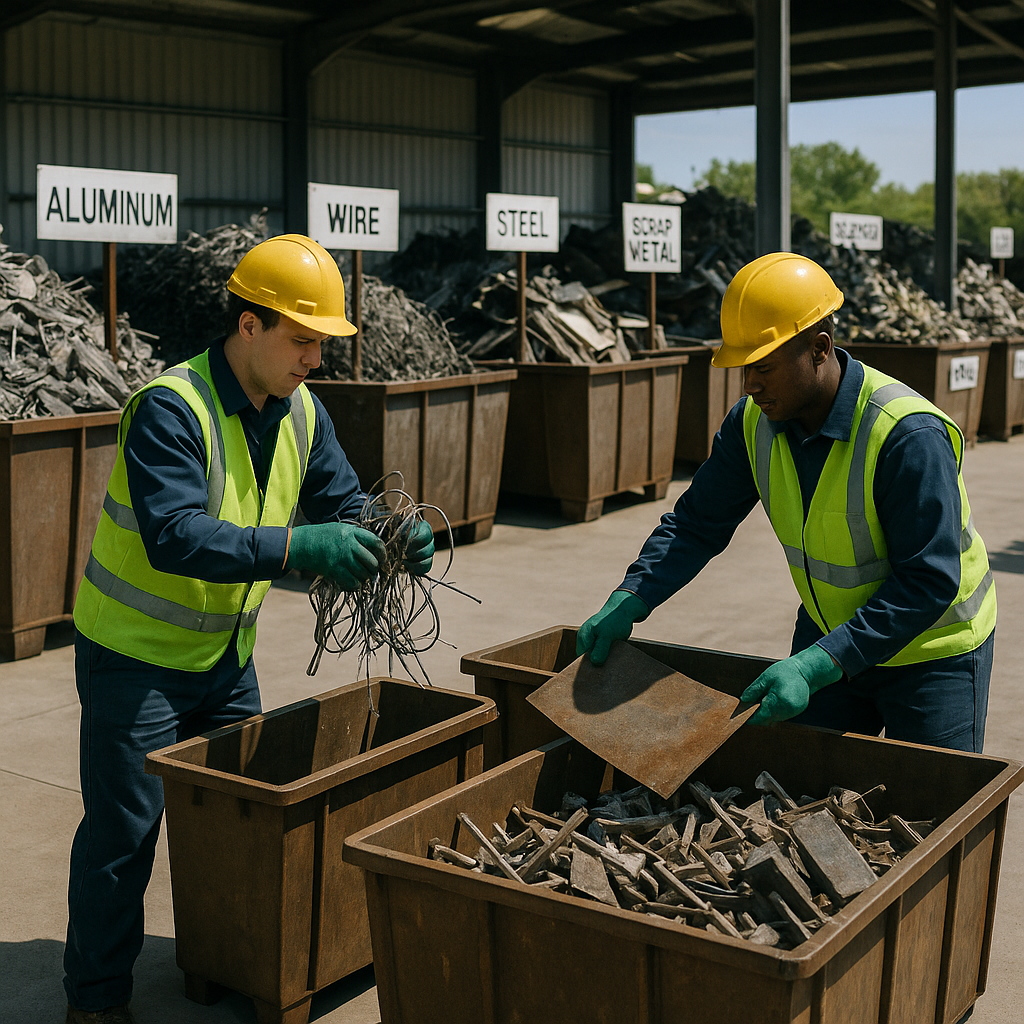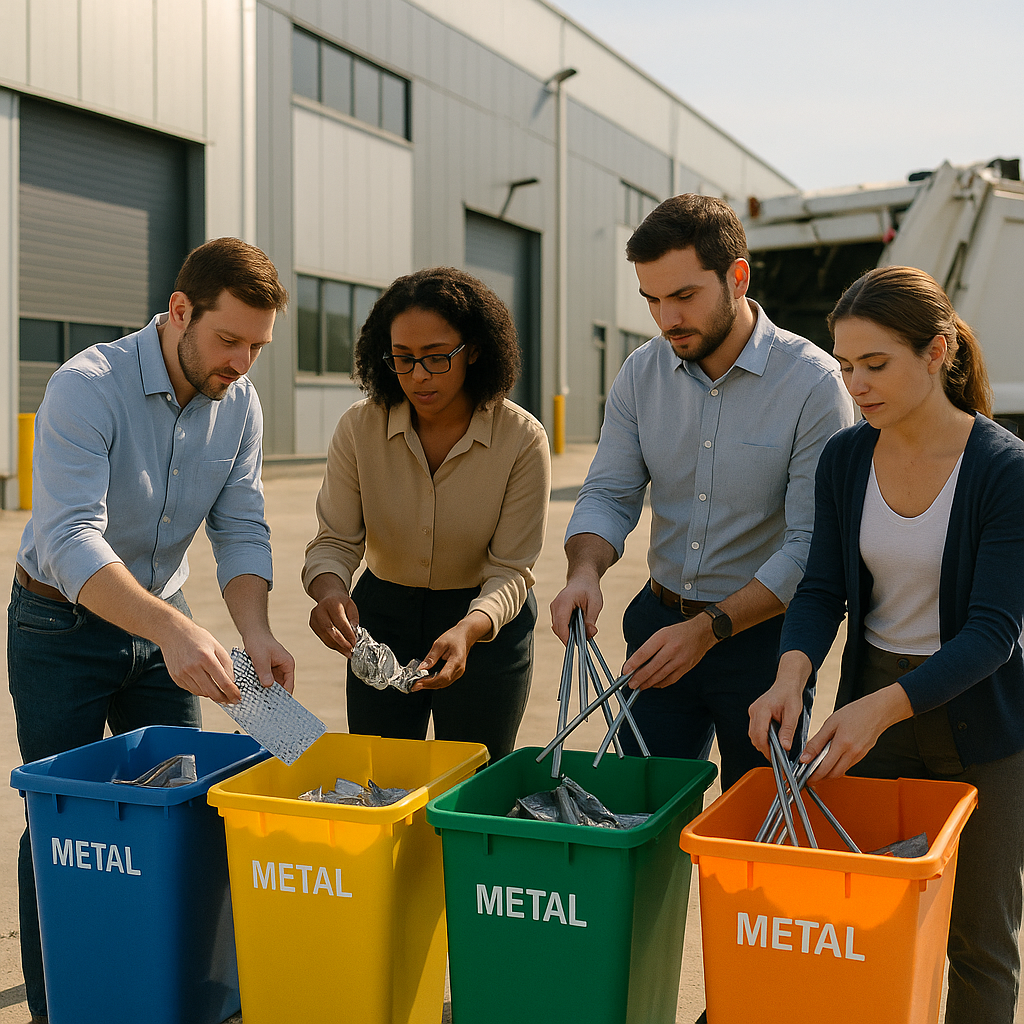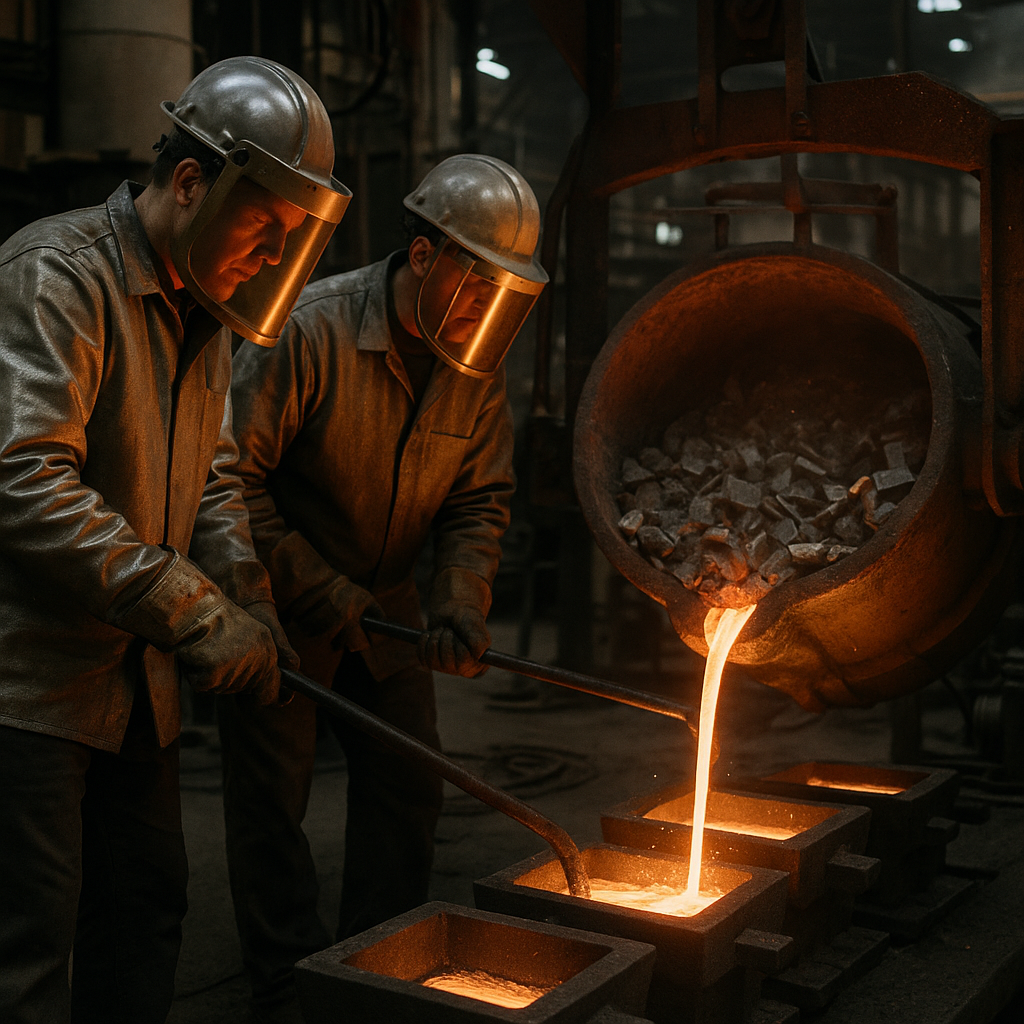5901 Botham Jean Blvd, Dallas, TX 75215
How Efficient Scrap Removal Boosts Productivity, Revenue, and Environmental Impact
August 21, 2025Every manufacturing facility generates leftover materials. Production lines stamping parts, cutting metal sheets, and machining components create excess metal with no immediate purpose. This material represents significant untapped value.
Industrial scrap removal is a specialized process that involves collecting, sorting, and processing unused metal materials from manufacturing and industrial facilities. This essential service transforms what might be considered waste into valuable resources through recycling channels. The metals typically managed include steel, aluminum, copper, brass, and other alloys remaining after production processes.
For manufacturing companies, proper scrap removal delivers multiple benefits beyond simple cleanup. It reclaims valuable floor space otherwise consumed by waste materials. Space efficiency directly improves operational effectiveness, allowing for streamlined workflows and potentially increased production capacity. Properly managed scrap also plays a significant role in sustainability initiatives that influence modern business decisions.
What Are the Key Steps in the Industrial Scrap Removal Process?

The industrial scrap removal process is designed to maximize resource recovery while ensuring operational efficiency. Understanding each stage helps businesses implement effective waste management strategies, transforming scrap metal from a disposal challenge into a resource.
Initial Assessment and Planning
Every successful scrap removal project begins with a thorough evaluation of materials for disposal. Recycling specialists assess the types and volumes of scrap to develop a tailored removal plan. This crucial step determines the necessary equipment, scheduling requirements, and most efficient removal methods.
For manufacturing facilities that generate scrap continuously, planning establishes ongoing management solutions that integrate with production processes. The assessment also identifies potential hazards and establishes handling protocols for specialized materials.
On-Site Services
The core of industrial scrap removal occurs at your facility through specialized on-site services. These include several key components to ensure proper handling and documentation.
Scrap weighing uses certified scales to ensure accurate measurement of materials. This documentation is the basis for proper payment and regulatory reporting. Quality inspection involves testing for contamination, including radiation detection and verification of metal composition to maintain material integrity.
On-site services also include strategic placement of storage solutions like containers, bins, or trailers to collect and store materials before transport. Loading assistance with specialized equipment and trained personnel completes this phase, ensuring materials are safely prepared for the next step.
Processing and Material Handling
Once collected, scrap materials require processing before recycling. This may occur on-site or at a dedicated facility, depending on volume and material types. Processing activities include dismantling equipment, decommissioning machinery, crushing bulky items, and shearing large pieces into manageable sizes.
Material separation is critical in this phase. Ferrous metals containing iron are separated from non-ferrous metals like aluminum, copper, and brass using magnetic separation and other specialized techniques. This separation ensures maximum value recovery and readies materials for recycling streams.
For large equipment or machinery, specialized techniques like lancing or baling reduce size and prepare materials for efficient transport. The goal is to transform diverse scrap into uniform, properly classified materials ready for recycling.
| Process | Basics | Advantages | Disadvantages |
|---|---|---|---|
| Machining | Cuts material from workpiece | High level of geometrical freedom, No costly tooling | Worse results with harder metals, Slow for mass production |
| Forging | Applies force to workpiece | Very strong parts, Compatible with desirable metals | Very high costs in all aspects, Limited geometrical freedom |
| Casting | Melts metal and forms it in a mold | Can be fast and repeatable, Range of processes | Tooling costs and lead times, Limited geometrical freedom |
| Powder Metallurgy | Forms part in mold then sinters it | Wide range of metals and alloys | Hazardous raw material |
| Additive Manufacturing | Fuses metal powder particles in successive layers | Very high level of geometrical freedom, No costly tooling | Slow for mass production, Limited part strength |
| Extrusion | Forces workpiece through shaped die opening | Fast for medium-large volumes | Limited geometrical freedom |
Transportation and Logistics Management
Efficient transportation is essential in the scrap removal process. Comprehensive logistics management ensures materials move smoothly from your facility to their final destination. Recycling providers coordinate various transportation methods, including trucks for local movement, railcars for regional transport, and cargo ships for international shipments.
This phase might involve scheduled pickups at regular intervals or on-demand service based on your production schedule. Many providers offer mill-direct shipments, transporting processed materials directly to mills or manufacturing facilities for recycling. This approach reduces handling steps and transportation costs while minimizing environmental impact.
Documentation and Compliance
Throughout the scrap removal process, proper documentation ensures regulatory compliance and provides transparency. This includes weight tickets, material classification records, and environmental compliance documentation to satisfy legal requirements.
Reputable recycling providers handle permitting requirements and ensure all activities meet Environmental Protection Agency guidelines. This documentation also supports sustainability reporting and waste reduction initiatives for your business, providing verifiable metrics for environmental performance.
Modern scrap management programs often provide real-time access to information through customer portals. These digital tools allow businesses to track materials and access important records, creating a transparent chain of custody from collection through final processing.
What Are the Benefits of Efficient Industrial Scrap Management?

Efficient industrial scrap management offers significant advantages for businesses across sectors. Companies that implement structured waste reduction programs often see improvements in profitability while enhancing their environmental credentials. Understanding these benefits enables organizations to implement strategic waste management initiatives that support both financial and sustainability goals.
Cost Savings Through Reduced Disposal and New Revenue Streams
The financial benefits of effective scrap management are substantial and immediate. Reducing waste sent to landfills decreases tipping fees and waste management costs. Manufacturing facilities that introduce effective segregation systems can cut waste disposal costs by 30-40% in the first year.
Beyond expense reduction, proper scrap management opens new revenue streams. Many types of industrial scrap, particularly metals, have significant market value. For instance, aluminum scrap typically fetches between $0.50-$0.80 per pound, while copper can command $2.50-$3.50 per pound, turning waste into direct income.
Companies also benefit from reduced raw material costs through internal recycling programs. An industrial packaging manufacturer, previously losing millions due to wasted tin, steel, and coating, implemented targeted improvements that reduced scrap by 22% in five weeks, saving $1.2 million annually by recovering valuable materials.
Improved Operational Efficiency and Productivity
Proper scrap management enhances operational efficiency in manufacturing facilities. Reducing waste frees up valuable floor space for productive activities. Cluttered production areas with excess scrap create bottlenecks that impact workflows and reduce productivity.
Companies that generate less scrap operate more efficiently, with reduced downtime and faster production cycles. Efficient scrap handling minimizes the time workers spend managing waste, allowing them to focus on value-added activities. This improved workflow creates a more organized production environment, naturally boosting productivity.
High scrap rates often signal underlying quality or process issues. By tracking and analyzing scrap data, manufacturers can identify and resolve these problems. Average manufacturers spend up to 2.2% of annual revenue on scrap and rework. Even small improvements multiply quickly. A $100 million company cutting its scrap rate by 10% saves $220,000 annually while enhancing product quality and consistency.
Environmental Sustainability and Resource Conservation
Efficient scrap management offers compelling environmental benefits, establishing businesses as responsible stewards of natural resources while helping meet vital sustainability targets.
Resource conservation is a primary environmental benefit. Recycling one ton of steel conserves approximately 2,500 pounds of iron ore, 1,400 pounds of coal, and 120 pounds of limestone. These savings across various materials significantly reduce the demand for resource extraction.
Proper scrap management dramatically reduces energy consumption compared to producing materials from virgin resources. Recycling aluminum uses 95% less energy than producing it from raw materials, and recycled steel production requires 60% less energy than making steel from virgin materials. These energy savings directly translate to lower greenhouse gas emissions, supporting climate action goals.
Effective scrap management also decreases landfill usage. As landfill space becomes increasingly limited and costly, diverting waste through recycling and reuse preserves land, preventing contamination of soil and groundwater.
| Benefit | Description |
|---|---|
| Cost Savings | Businesses minimize landfill waste, reducing tipping fees and waste management costs by 30-40% in the first year. |
| New Revenue Streams | Aluminum scrap values between $0.50-$0.80 per pound; copper between $2.50-$3.50 per pound, creating direct income from recyclables. |
| Operational Efficiency | Freed floor space from reduced scrap leads to improved workflows and production capacity. |
| Resource Conservation | Recycling one ton of steel conserves 2,500 pounds of iron ore, 1,400 pounds of coal, and 120 pounds of limestone. |
| Lower Energy Usage | Recycling aluminum uses 95% less energy than producing it from raw materials; recycled steel requires 60% less energy. |
| Regulatory Compliance | Avoids penalties associated with improper waste disposal and strengthens corporate responsibility image. |
Enhanced Corporate Reputation and Regulatory Compliance
Businesses that prioritize efficient scrap management improve their reputation among customers, partners, and communities. As sustainability gains importance for consumers and investors, companies with proven waste reduction initiatives gain competitive advantages.
Proper scrap management helps industrial companies comply with increasingly stringent environmental regulations, avoiding penalties. Documenting recycling efforts and disposal practices demonstrates regulatory compliance and corporate responsibility.
Strategic scrap management enables companies not only to save costs and generate new revenue but also to strengthen their environmental credentials. This dual advantage makes efficient scrap management essential for businesses committed to sustainable operations.
How Can Businesses Optimize Their Scrap Metal Collection?

Effective scrap metal collection relies on systematic organization and strategic implementation. Without proper management, valuable materials end up in landfills instead of generating revenue. By adopting structured sorting systems, businesses can enhance recycling efficiency by up to 30%, while also reducing disposal costs and environmental impact.
Implement Systematic Sorting Procedures
Proper sorting forms the foundation of effective scrap metal recycling. Set up clearly labeled, color-coded containers throughout your facility to separate different metal types, preventing contamination and preserving material value.
Begin by separating ferrous metals (containing iron) from non-ferrous metals (aluminum, copper, brass). Use magnetic separation as a quick and effective sorting method. Magnets attract ferrous metals while non-ferrous materials remain unaffected, significantly improving sorting accuracy.
For businesses handling large volumes of scrap, create designated sorting areas with adequate space and appropriate equipment. Organize your collection points based on material type and establish a workflow that minimizes material handling.
Invest in Employee Training
A well-designed recycling program requires proper staff education. Employees must understand both the procedures and the importance of proper scrap handling.
Develop comprehensive training programs covering metal identification, proper handling techniques, and safety protocols. Use visual aids like posters and sample materials to help workers recognize different metals and their characteristics.
Consider appointing recycling champions within departments to maintain momentum and address questions. These advocates can provide guidance and ensure sorting compliance throughout your operation.
Regular refresher sessions keep recycling practices top of mind and address emerging issues. Recognize and reward departments or individuals who consistently demonstrate proper sorting practices to reinforce positive behavior.
Partner with Specialized Recycling Companies
Building strong relationships with reputable recycling partners is essential for maximizing the value of your scrap metal. Research multiple recyclers to find those offering the best rates and services for your materials.
Look for recycling companies that provide container drop-off services and convenient collection schedules. Some offer revenue-sharing programs for high-value materials, creating additional financial incentives for your business.
When evaluating potential partners, consider their processing capabilities, proximity to your facility, and sustainability practices. Transportation costs can significantly impact economic viability, so nearer facilities often offer better overall value.
Establish clear agreements outlining responsibilities, pricing structures, and material quality requirements. Regular communication with your recycling partner helps adapt to changing market conditions and processing requirements.
Consider On-Site Processing Equipment
For businesses generating large scrap metal volumes, investing in on-site processing equipment can deliver substantial returns. Balers, shredders, and compactors reduce material volume, cutting transportation costs and increasing storage efficiency.
Portable metal shears and hydraulic presses allow for initial processing of larger metal pieces, making them easier to handle and transport. These tools can significantly improve your collection system’s efficiency while reducing labor costs.
Advanced sorting technologies like eddy current separators enhance processing capabilities for operations with diverse streams. While initial investment may be significant, these systems often pay for themselves through improved material recovery and higher scrap values.
Conduct a thorough cost-benefit analysis before purchasing equipment, considering factors like maintenance requirements, operational costs, and expected return on investment. Some recycling partners offer equipment leasing options, reducing upfront costs.
Implement Tracking and Analysis Systems
Data-driven approaches help optimize scrap metal collection over time. Implement systems to track material volumes, types, values, and contamination rates, identifying improvement opportunities and demonstrating program success.
Start with baseline measurements before launching improvements, then collect data regularly to monitor progress. Simple spreadsheets work for basic tracking, but dedicated software offers more comprehensive analysis capabilities.
Regularly review performance metrics to identify trends and address issues promptly. Schedule quarterly evaluations to assess collection efficiency, sorting accuracy, and overall program effectiveness. Use this information to refine processes and maximize returns.
Share performance data with staff to build program awareness and demonstrate impact. Knowing their efforts produce measurable results encourages continued participation and engagement with your recycling initiatives.
By implementing these optimization strategies, businesses can transform their scrap metal collection from a waste management challenge into a valuable resource recovery operation. Systematic sorting, employee training, strategic partnerships, appropriate equipment, and data-driven management create a comprehensive approach that delivers both environmental and financial benefits.
Conclusion: Transforming Industrial Waste into Valuable Resources

Efficient factory scrap removal reflects a fundamental shift in how we perceive industrial waste. Instead of viewing waste as a burden, progressively-minded businesses now see it as a valuable resource with substantial potential. By adopting best practices in sorting and processing materials, companies can maximize value from their waste streams while minimizing their environmental impact.
This transformation offers benefits beyond environmental stewardship. Cost savings from reduced disposal fees, potential revenue from selling recyclable materials, and enhanced operational efficiency create a strong business case for effective scrap management. As regulations tighten and consumers increasingly prefer sustainable businesses, establishing efficient waste management systems has become not just environmentally responsible but economically essential for modern manufacturing operations.
Interested in turning your industrial waste from a liability into an asset? Contact Okon Recycling at 214-717-4083 for specialized scrap removal services tailored to your specific needs.
